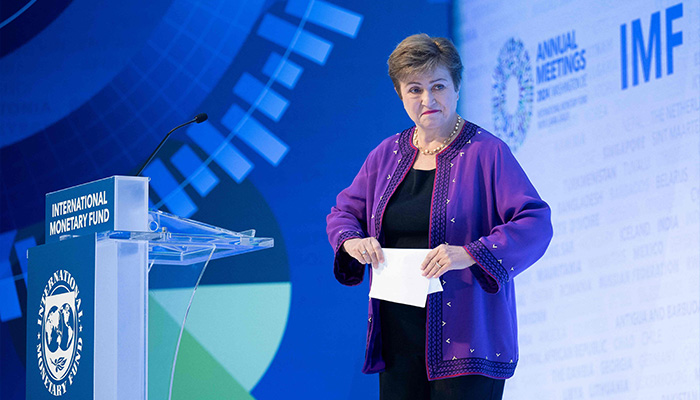
- “Rising protectionism and trade restrictions fracture the global economy.”
- Global trade is no longer the engine of growth it once was: International Monetary Fund head.
- Georgieva delivers a speech before the annual meetings of the International Monetary Fund and the World Bank.
New IMF forecasts point to a difficult future for the global economy characterized by lackluster medium-term growth, escalating trade tensions and high debt levels, International Monetary Fund Director Kristalina Georgieva said on Thursday.
Georgieva painted a sobering picture in a speech ahead of the annual meetings of the International Monetary Fund and World Bank next week, but she said there was still a lot that could be done to boost growth, reduce debt and build a more resilient economy.
It warned of continued high prices that disproportionately affect the poor, and of the possibility that the escalating conflict in the Middle East could destabilize regional economies and global commodity markets.
Georgieva also expressed concerns about increased military spending affecting funding available for other priorities, including aid to developing countries.
Georgieva, who began her second five-year term this month, said rising protectionism and increased trade restrictions had fractured the global economy, limiting trade growth and “pours cold water on an already tepid global economy.”
“I am not too pessimistic, because if you look at the trajectory of the global economy, yes, we can do better, but we can also do much worse,” Georgieva said during a discussion at IMF headquarters ahead of next week’s meetings. .
She added that global trade is no longer the engine of growth that it once was, but “it has not headed in the opposite direction,” noting that decades of interdependence were a mitigating factor for the jump in trade restrictions that have accumulated since the Covid pandemic.
She said there was some good news, including a decline in global inflation and a return in the direction of price stability, with labor markets calming in an orderly manner in the United States and Europe.
She said the U.S. was not in a recession, despite the Fed initiating interest rate cuts that led to declines in the past three interest rate cycles, and jobless numbers were expected to remain relatively low.
“Our forecasts point to an inexorable mix of low growth and high debt – a difficult future,” Georgieva said, pointing to mixed economic outlooks for major players.
Growth in China was slowing while growth in India was accelerating; She told the International Monetary Fund that the United States was performing “very well,” but Europe could do better.
Overall growth will not be sufficient to eradicate global poverty, create the necessary number of job opportunities, or generate the tax revenues necessary to service heavy debt burdens and finance investments.
Georgieva said higher and higher public debt made the outlook more worrying, noting that a “severe but plausible” downside scenario could push debt 20 percentage points of GDP above its current forecast.
This means that governments will face painful choices about where to spend their precious money, and the challenges have been greatest in emerging market economies.
She added that in order to change course and stimulate more growth, countries need to reduce debt, rebuild the necessary reserves to face the next shock, reduce spending and boost productivity.
She said global cooperation has become more important than ever, pointing to ongoing trade challenges, unpredictable rapid global warming, and the rapid growth of artificial intelligence technology that requires global regulatory and ethical rules.
“I expect people will leave here feeling a little bit happier, a little bit more scared, and I hope they’re afraid to be pushed into action,” she said.



